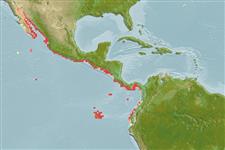>
Holocentriformes (Squirrelfishes, soldierfishes) >
Holocentridae (Squirrelfishes, soldierfishes) > Myripristinae
Etymology: Myripristis: Greek, myros, -ou = male of morey eel + Greek, pristis = saw (Ref. 45335).
More on author: Valenciennes.
Environment: milieu / climate zone / profondeur / distribution range
Écologie
marin récifal; profondeur 3 - 24 m (Ref. 5227). Tropical; 32°N - 1°S
Eastern Pacific: Gulf of California to Ecuador, including the Galapagos Islands. Also found in the Revillagigedo and Cocos islands (Ref. 36626).
Taille / Poids / Âge
Maturité: Lm ? range ? - ? cm
Max length : 18.0 cm TL mâle / non sexé; (Ref. 55763); common length : 12.0 cm TL mâle / non sexé; (Ref. 55763)
Description synthétique
Clés d'identification | Morphologie | Morphométrie
Épines dorsales (Total) : 11; Rayons mous dorsaux (Total) : 12 - 15; Épines anales: 4; Rayons mous anaux: 11 - 13; Vertèbres: 26. Branchiostegal rays: 8-8 (Ref. 36626).
Body shape (shape guide): fusiform / normal.
Adults hide under conspicuous rocks and small caves during the day. Form small groups on rocky and occasionally soft substrates or near the surface at night. Feed principally on crustaceans. Oviparous, with planktonic larvae (Ref. 36626). Appear occasionally in markets and marketed fresh.
Life cycle and mating behavior
Maturité | Reproduction | Frai | Œufs | Fécondité | Larves
Schneider, W. and F. Krupp, 1995. Holocentridae. Candiles. p. 1182-1185. In W. Fischer, F. Krupp, W. Schneider, C. Sommer, K.E. Carpenter and V. Niem (eds.) Guia FAO para Identification de Especies para lo Fines de la Pesca. Pacifico Centro-Oriental. 3 Vols. FAO, Rome. (Ref. 9307)
Statut dans la liste rouge de l'IUCN (Ref. 130435: Version 2025-1)
Menace pour l'homme
Harmless
Utilisations par l'homme
Pêcheries: intérêt commercial mineur
Outils
Articles particuliers
Télécharger en XML
Sources Internet
Estimates based on models
Preferred temperature (Réf.
123201): 22.4 - 29.1, mean 26.7 °C (based on 225 cells).
Phylogenetic diversity index (Réf.
82804): PD
50 = 0.5000 [Uniqueness, from 0.5 = low to 2.0 = high].
Bayesian length-weight: a=0.01950 (0.01084 - 0.03506), b=3.13 (2.98 - 3.28), in cm total length, based on LWR estimates for this species & Genus-body shape (Ref.
93245).
Niveau trophique (Réf.
69278): 3.1 ±0.30 se; based on food items.
Résilience (Réf.
120179): Haut, temps minimum de doublement de population inférieur à 15 mois (Preliminary K or Fecundity.).
Fishing Vulnerability (Ref.
59153): Low vulnerability (10 of 100).
🛈
Nutrients (Ref.
124155): Calcium = 86.6 [41.8, 270.8] mg/100g; Iron = 0.931 [0.402, 1.955] mg/100g; Protein = 18.2 [17.0, 19.4] %; Omega3 = 0.148 [0.060, 0.350] g/100g; Selenium = 29.6 [17.0, 57.1] μg/100g; VitaminA = 111 [42, 297] μg/100g; Zinc = 1.62 [1.04, 2.52] mg/100g (wet weight);
